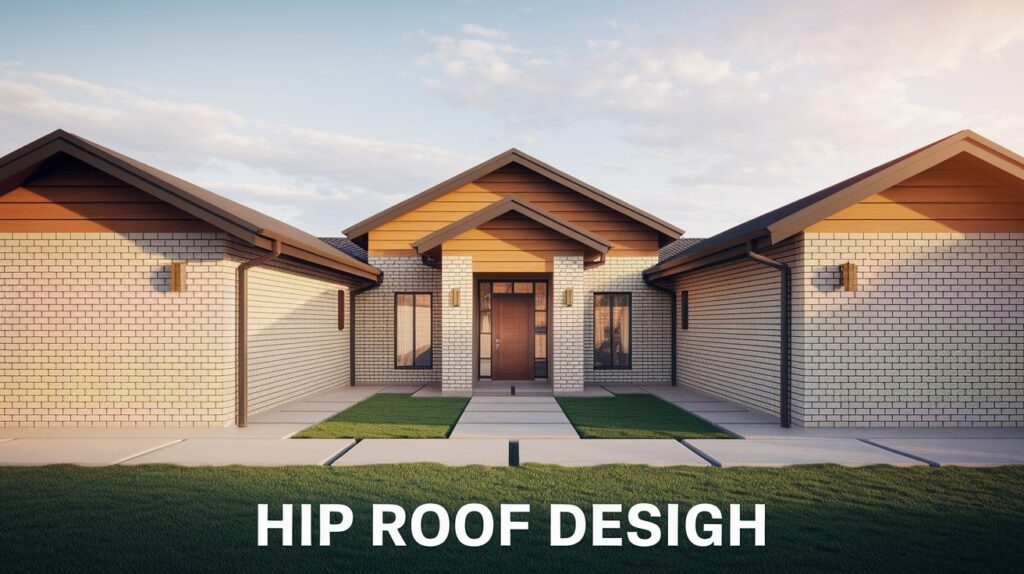A hip roof is a popular roofing style where all sides slope downward from the peak. Unlike gable roofs that have vertical ends, hip roofs feature sloped surfaces on every side of the structure.
This design offers excellent stability and weather resistance. That’s why you’ll see hip roofs on homes across different climates and architectural styles.
In this guide, I’ll walk you through everything about hip roofs. You’ll learn about different types, benefits, drawbacks, and costs. I’ll also cover materials, structural components, and ventilation tips.
Making the right roof choice affects your home for decades. The wrong decision can lead to expensive repairs, poor performance, or regret. That’s why understanding your options matters so much.
By the end, you’ll know if a hip roof fits your building project. Let’s start with the basics and work our way through the details.
What Is a Hip Roof?
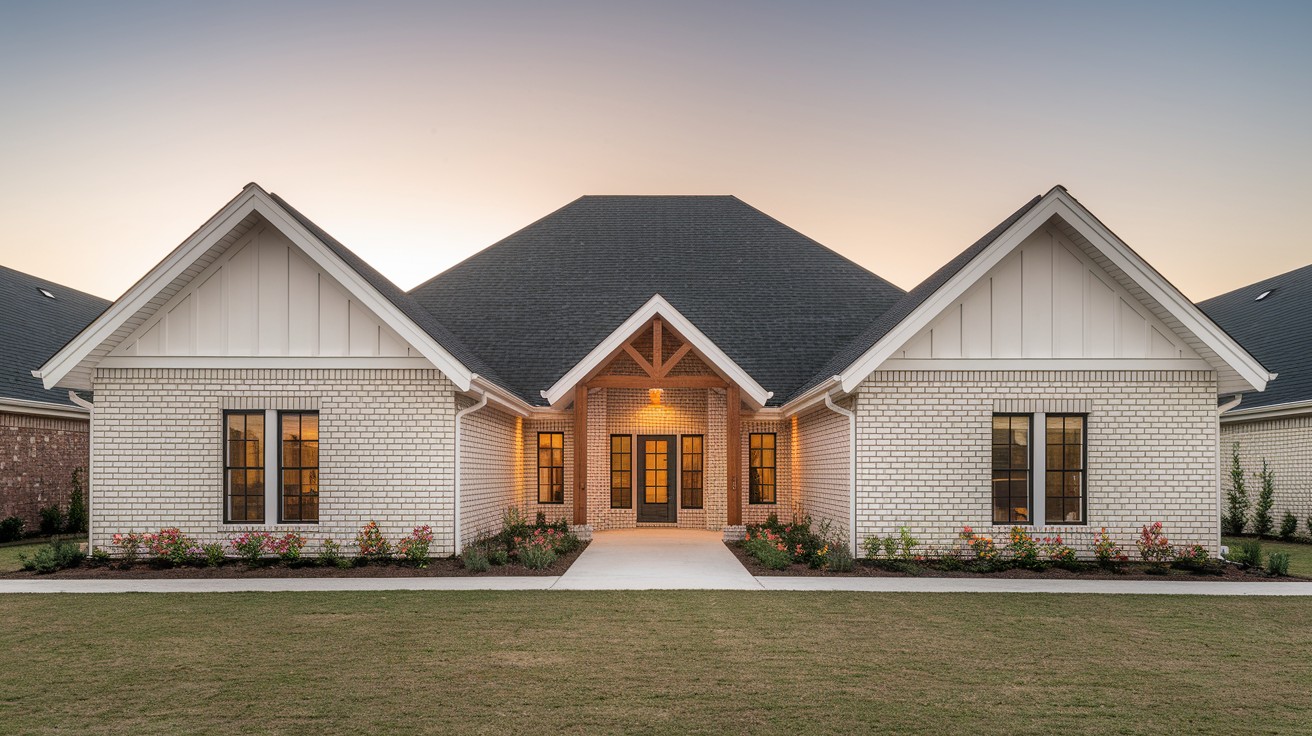
A hip roof slopes down on all four sides of a building. The slopes meet at the top to form a ridge line. This creates a pyramid-like shape when viewed from above.
Think of it this way: imagine folding a piece of paper into a tent shape. Now fold the ends down too. That’s essentially what a hip roof looks like.
Key differences from gable roofs:
- Gable roofs have two sloping sides and two vertical triangular ends
- Hip roofs have four sloping sides with no vertical ends
- Hip roofs create a more compact, symmetrical appearance
Main characteristics:
- All sides slope at the same angle
- No exposed vertical walls at the ends
- The ridge line runs along the center
- Creates natural overhangs on all sides
Types of Hip Roof Designs
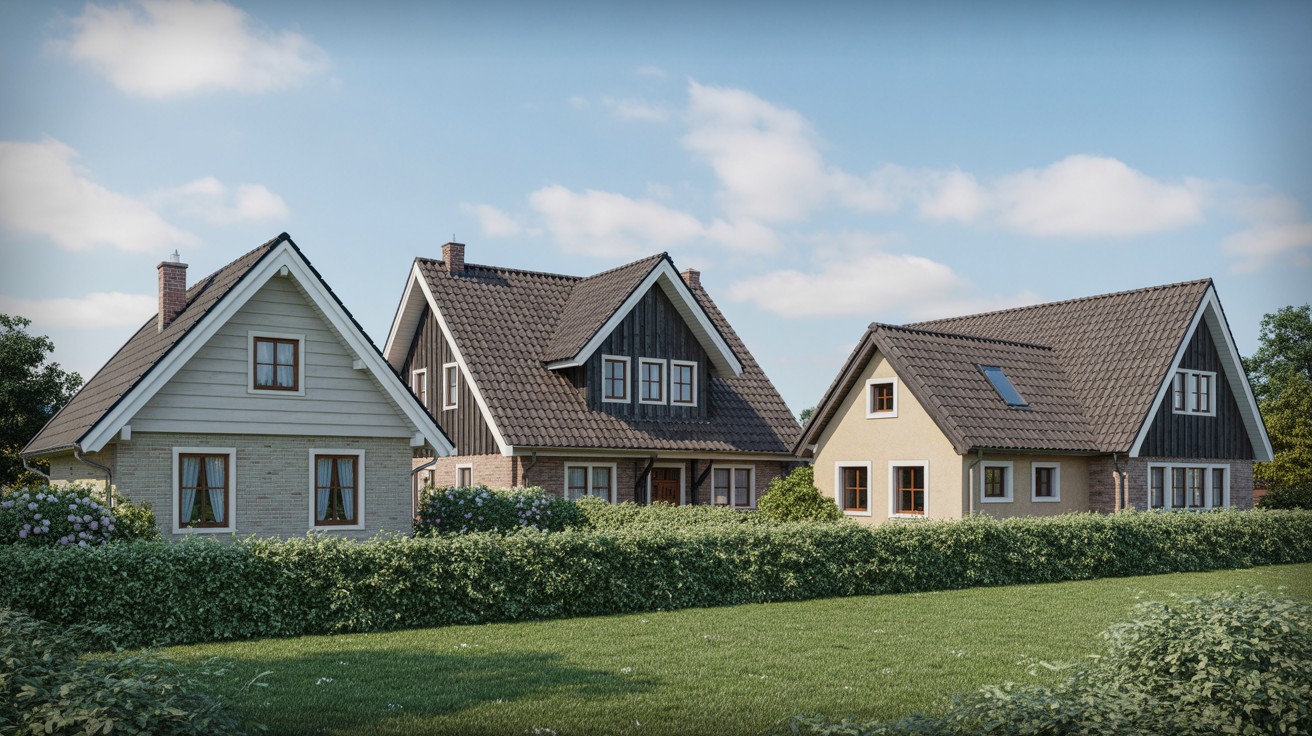
Simple Hip Roof
The most basic type. Four identical slopes meet at a central ridge. Perfect for square or rectangular homes.
Best for: Small to medium-sized homes, ranch-style houses
Cross Hip Roof
Combines multiple hip roof sections. Common on L-shaped or complex floor plans. Each section has its ridge line.
Best for: Larger homes with wings or additions, complex architectural layouts
Half Hip Roof
Also called a clipped gable. Starts like a gable roof, but the ends are clipped at an angle. This creates a small hip section.
Best for: Homes that need gable benefits but want some hip roof advantages
Dutch Gable Roof
A hybrid design. Features a hip roof base with a small gable section on top. Combines the benefits of both styles.
Best for: Homes needing extra attic space while maintaining hip roof stability
Benefits & Drawbacks of Hip Roofs
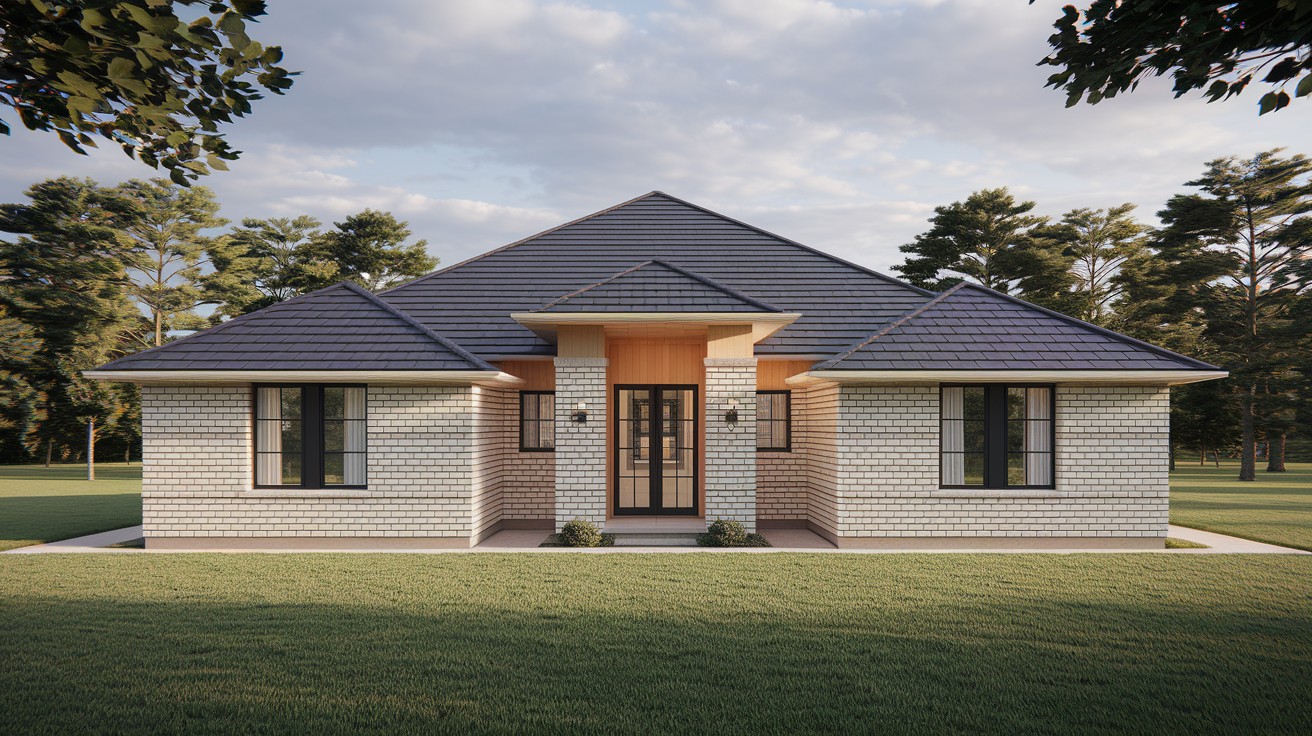
Benefits of Hip Roofs
- Superior Wind Resistance: Hip roofs excel in high winds because the sloped design on all sides creates less surface area for wind to catch. Wind flows over the roof instead of pushing against vertical surfaces.
- Efficient Water Drainage: Water runs off quickly from all sides with no flat surfaces for pooling or ice dams. The design naturally guides water toward gutters, reducing leak risks.
- Balanced Appearance: The symmetrical design creates a harmonious look that complements many architectural styles. This polished appearance from every angle can increase curb appeal and property value.
- Complete Protection: Every side of your home gets protection from overhanging eaves. This shields walls from rain and sun damage while supporting gutters around the entire perimeter.
Drawbacks to Consider
- Higher Cost and Complexity: Hip roofs require more materials and labor than simple gable roofs. The complex angles need precise cutting and experienced contractors, increasing both material and labor costs.
- Reduced Attic Space: The sloped design on all sides limits usable attic space. You’ll have less room for storage or potential living areas compared to gable roofs.
- Ventilation Challenges: Proper airflow requires careful planning, as the design can create dead air spaces. You’ll need strategic vent placement and possibly additional ventilation components.
- Skilled Labor Required: Hip roofs involve complex calculations and precise cuts. Not all contractors have this experience, which can make finding skilled workers more time-consuming and expensive.
Structural Components of a Hip Roof
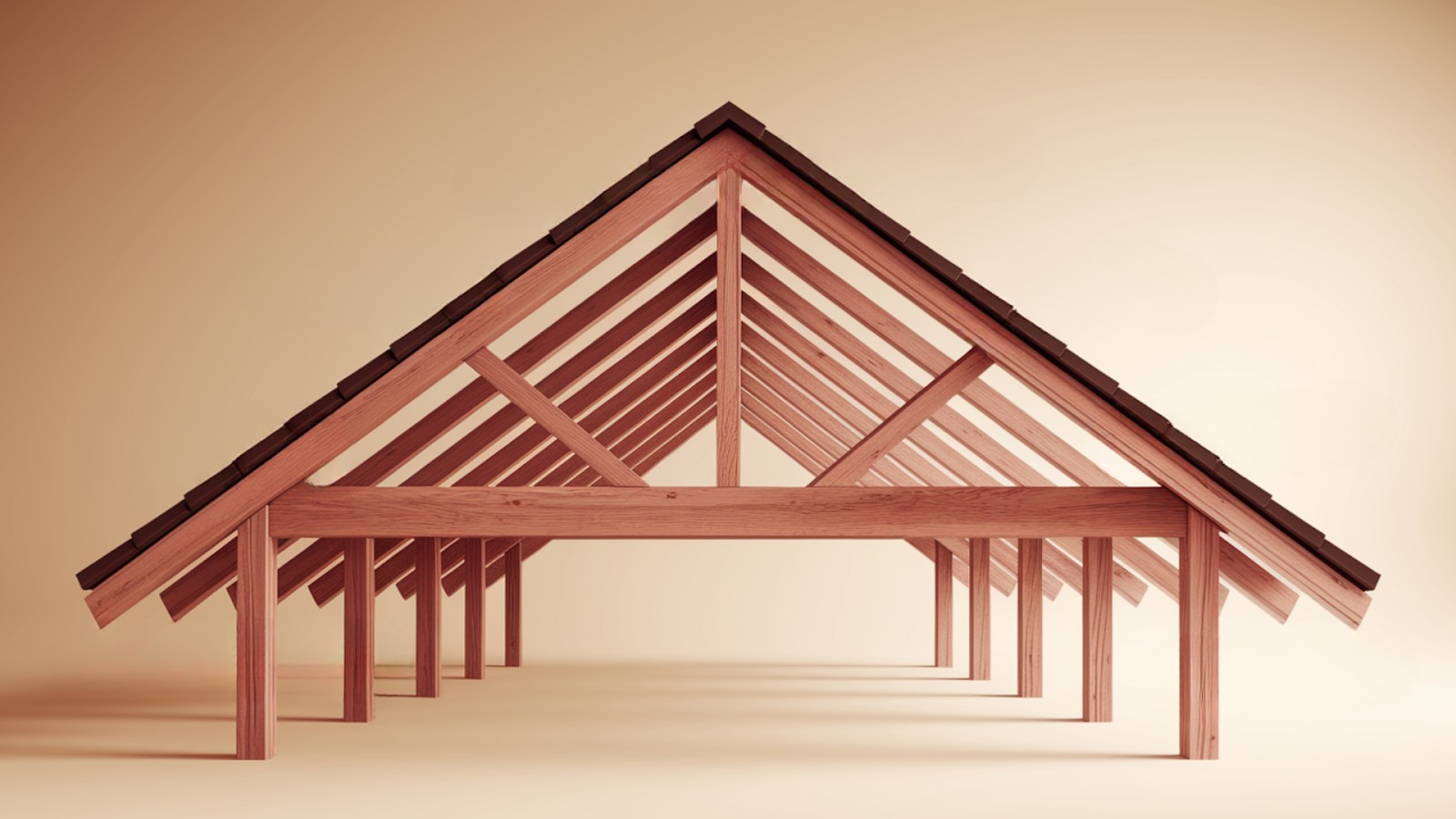
Rafters
The main support beams create the roof slope. Common rafters run from the ridge to the wall plate at regular intervals.
These carry the weight of the roof covering and transfer loads to the walls below.
Ridge Board
The horizontal beam at the peak where rafters meet. It provides a nailing surface and helps maintain the roof’s shape.
The ridge board runs along the centerline of the roof structure.
Hip Rafters
Diagonal rafters that form the corners where two roof planes meet. These are longer and stronger than common rafters.
Hip rafters carry loads from jack rafters and transfer them to the building’s corners.
Jack Rafters
Shorter rafters that run from the wall plate to the hip rafter. They don’t extend to the ridge.
Jack rafters fill in the roof plane between common rafters and hip rafters.
Importance of Accurate Pitch and Angles: Every cut must be precise for proper fit. Small errors can cause gaps, weak joints, or structural problems.
Best Materials for Hip Roof Construction
|
Material |
Pros |
Cons |
Best For |
|
Asphalt Shingles |
Affordable, easy installation, many color options, good for moderate climates |
Shorter lifespan (15-30 years), can be damaged by severe weather |
Budget-conscious homeowners, in moderate climates |
|
Clay/Concrete Tiles |
Long-lasting (50+ years), fire-resistant, energy-efficient, great for hot climates |
Heavy (requires strong structure), expensive, can break if walked on |
Mediterranean styles, hot climates, and long-term investment |
|
Metal Roofing |
Extremely durable (40-70 years), lightweight, energy efficient, handles snow well |
Higher upfront cost, can be noisy, requires skilled installation |
Modern homes, areas with severe weather, and energy-conscious owners |
|
Slate |
Premium appearance, extremely long-lasting (75-100+ years), fire resistant, low maintenance |
Very expensive, extremely heavy, requires specialized installation |
Historic homes, luxury applications, and permanent installations |
Cost Factors
Hip roofs typically cost 10-20% more than gable roofs due to their complexity.
Average cost estimates per square foot:
- Basic hip roof: $8-12 per square foot
- Complex hip roof: $12-18 per square foot
- Premium materials: $15-25+ per square foot
Factors affecting total cost:
- Size: Larger roofs require more materials and labor
- Pitch: Steeper roofs are harder to work on and require more materials
- Materials: Premium materials significantly increase costs
- Labor: Complex designs need skilled contractors at higher rates
Budgeting tips:
- Get multiple quotes from experienced contractors
- Consider long-term value, not just upfront costs
- Factor in maintenance and replacement timelines
- Plan for a 10-15% contingency for unexpected issues
Ideal Home Styles for Hip Roofs
Ranch-style homes: Hip roofs complement the horizontal lines and single-story design. The low profile matches the home’s proportions perfectly.
Bungalow houses: The compact, symmetrical design works well with bungalow architecture. Hip roofs enhance the cozy, cottage-like appearance.
Mediterranean homes: Clay tile hip roofs are classic for this style. The design handles the climate well and matches the architectural tradition.
Colonial houses: Hip roofs can modernize colonial designs while maintaining their formal appearance. The symmetry complements the balanced facade.
The key is matching roof proportions to your home’s scale and style. A hip roof should enhance your home’s character, not compete with it.
Ventilation and Insulation Tips
Ventilation Methods:
- Install ridge vents along the peak for hot air exhaust
- Add soffit vents under eaves for cool air intake
- Use roof vents on slopes if ridge vents aren’t sufficient
- Consider gable vents if you have any vertical surfaces
- Ensure continuous airflow from the intake to the exhaust
Preventing Moisture Buildup:
- Create proper vapor barriers in the attic
- Seal air leaks around penetrations
- Maintain consistent temperatures to prevent condensation
- Monitor humidity levels, especially in winter
Energy-Efficient Insulation:
- Use adequate R-value insulation for your climate zone
- Install insulation properly without gaps or compression
- Consider radiant barriers in hot climates
- Ensure insulation doesn’t block ventilation paths
Is a Hip Roof Right for Your Home?
Consider these factors:
- Climate: Hip roofs excel in windy areas and regions with severe weather
- Budget: Expect 10-20% higher costs than gable roofs
- Home style: Works best with ranch, bungalow, Mediterranean, and colonial designs
- Attic needs: Not ideal if you need maximum attic storage or living space
- Maintenance: Generally requires less maintenance than gable roofs
- Resale value: Often increases home value due to attractive appearance and durability
- Local building codes: Check if your area has specific requirements or restrictions
Conclusion
Hip roofs offer excellent weather resistance and create attractive, symmetrical home designs. They handle wind and water better than many other roof styles. The all-around eaves protect your home’s exterior.
However, they cost more to build and maintain than simpler designs. The complex construction requires skilled contractors. You’ll also sacrifice some attic space compared to gable roofs.
Consider your climate, budget, and home style when making this decision. Hip roofs work best in areas with severe weather and on homes where appearance matters.
Before committing to any roof design, consult with experienced roofing professionals. They can assess your specific situation and recommend the best solution for your needs and budget.
Frequently Asked Questions
How much more does a hip roof cost compared to a gable roof?
Hip roofs typically cost 10-20% more than gable roofs due to their complex design and additional materials. The exact difference depends on your home’s size, pitch, and chosen materials.
Can I convert my existing gable roof to a hip roof?
Yes, but it’s a major renovation requiring structural modifications. You’ll need to add new framing, modify the roof structure, and potentially strengthen the walls. Consult a structural engineer before proceeding.
Do hip roofs work well in snowy climates?
Hip roofs handle snow reasonably well due to their sloped design. However, the complex angles can create areas where snow accumulates. Proper insulation and ventilation help prevent ice dams.
What’s the minimum pitch recommended for a hip roof?
Most hip roofs work best with a pitch of 4/12 or steeper (4 inches of rise per 12 inches of run). Lower pitches can work, but may require special waterproofing and drainage considerations.
How often do hip roofs need maintenance?
Hip roofs generally need less maintenance than gable roofs due to their wind resistance. However, inspect them annually for loose shingles, damaged flashing, and gutter issues. Professional inspections every 3-5 years are recommended.

